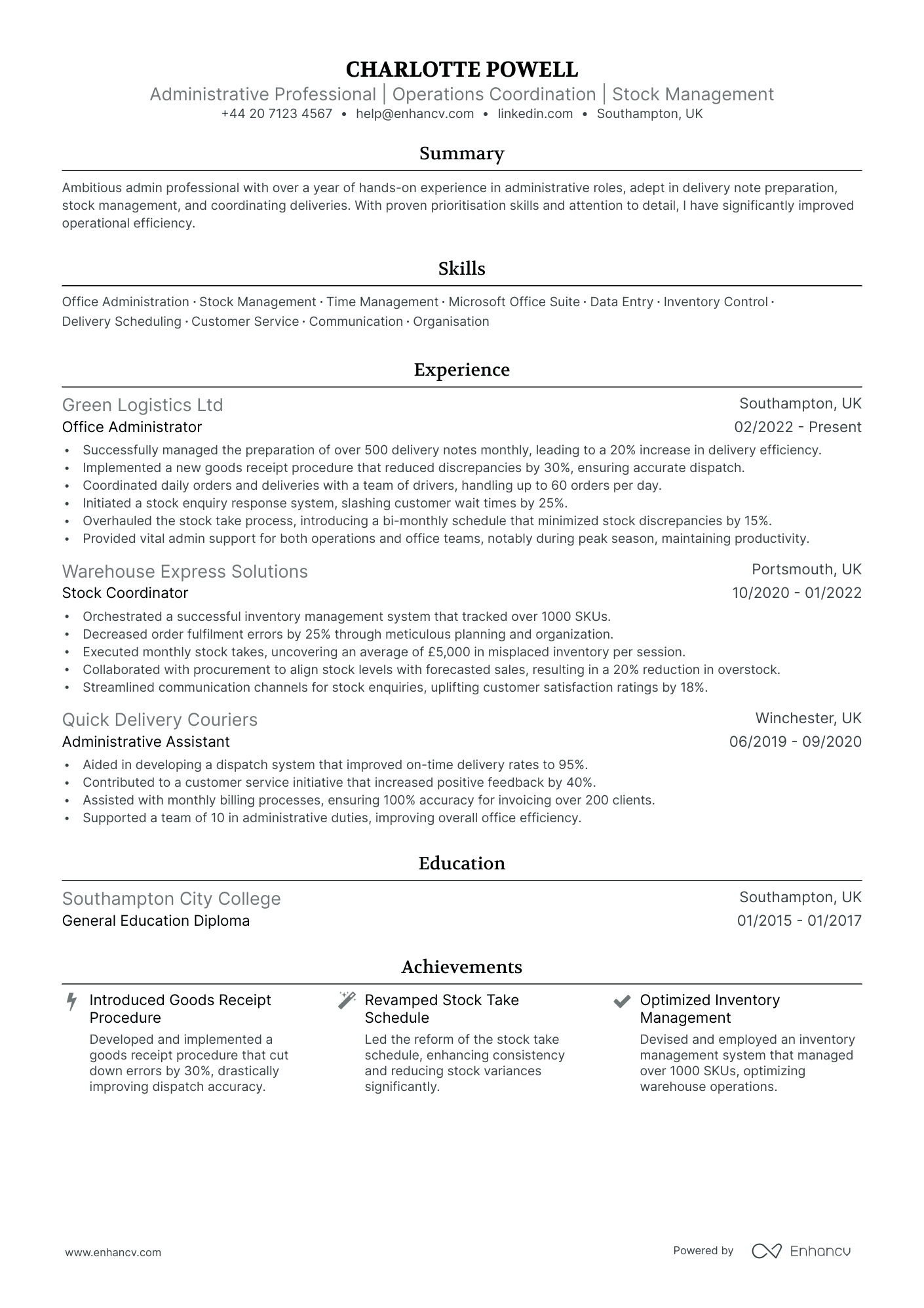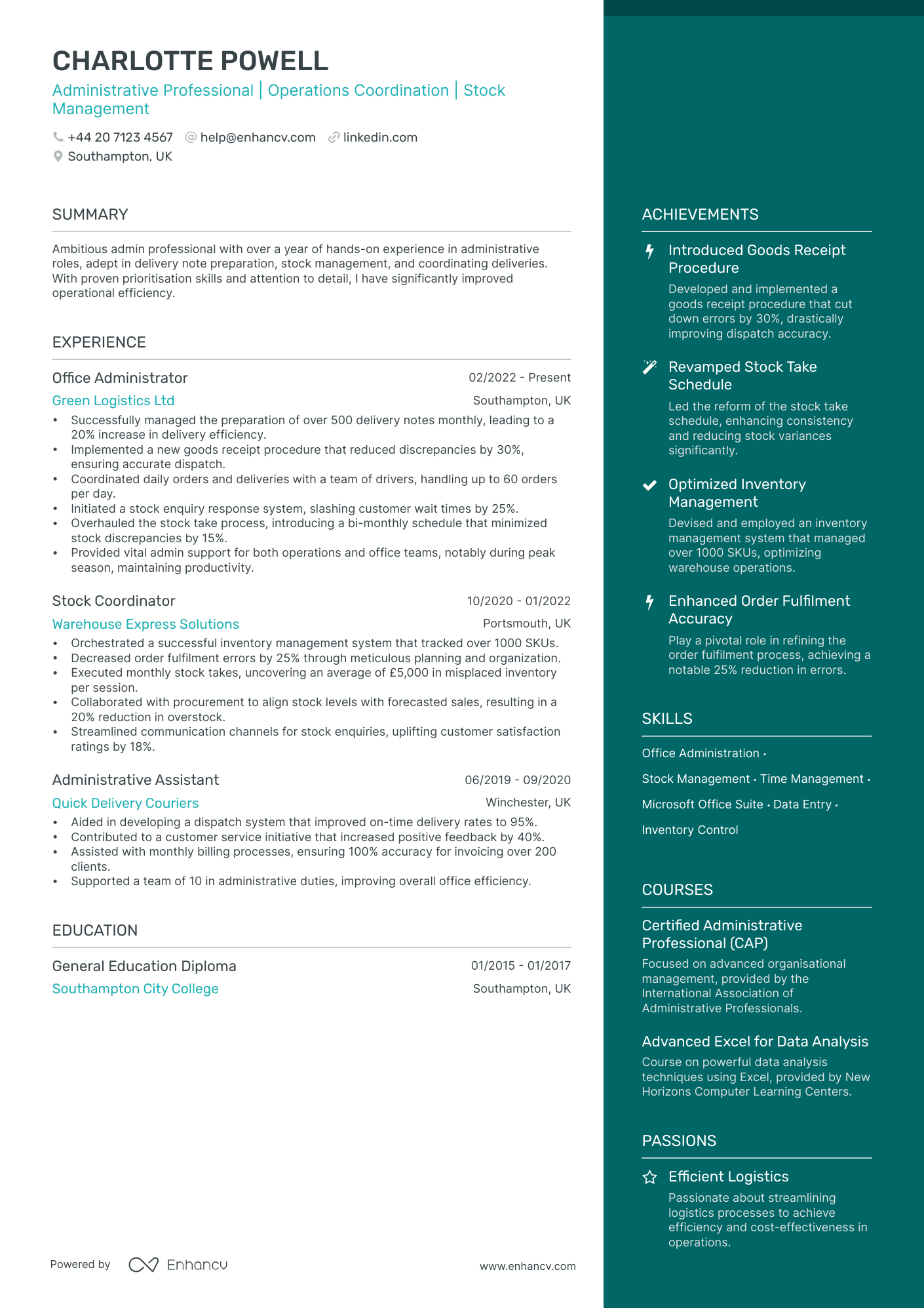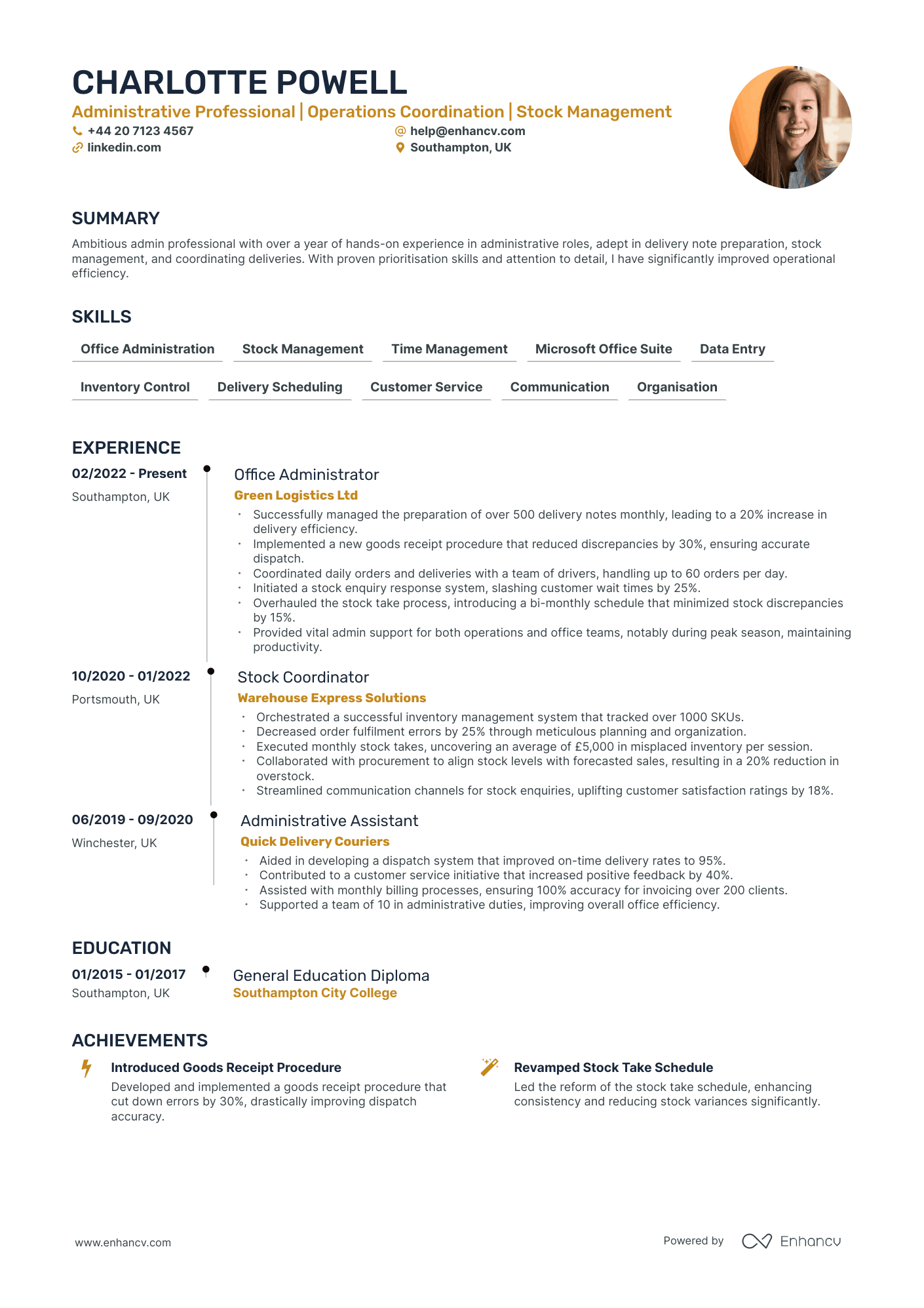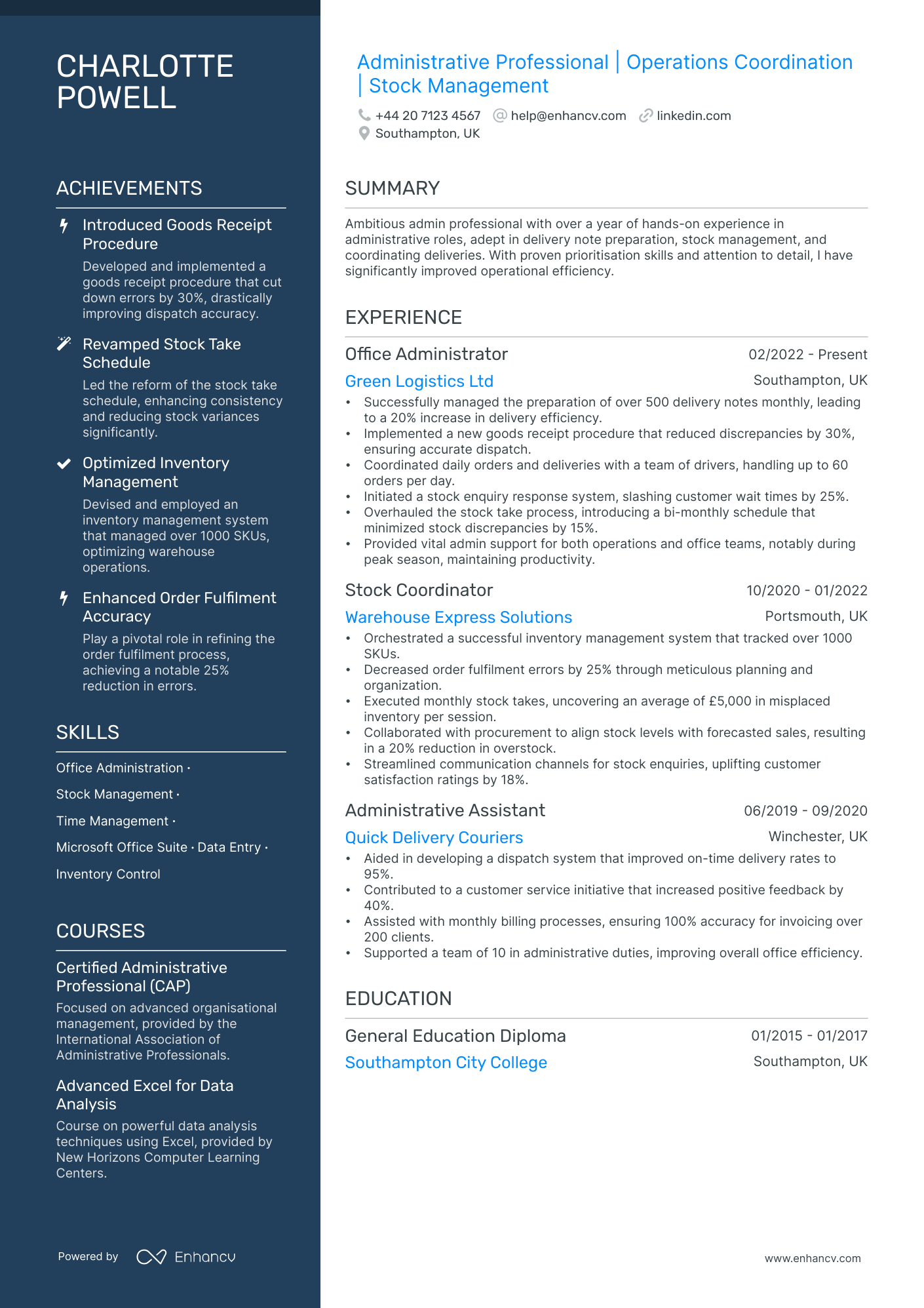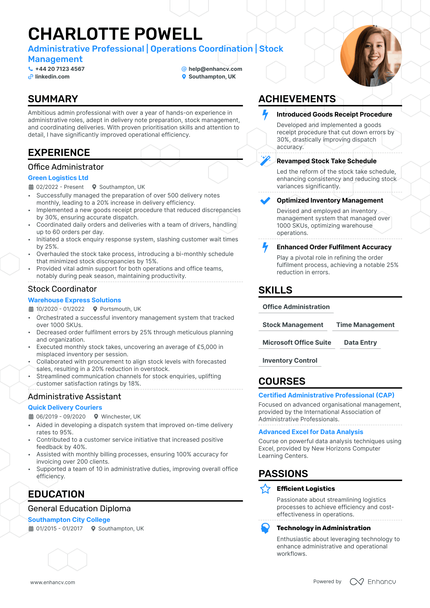One common CV challenge faced by warehouses is the efficient and accurate sorting of items using computer vision systems. Our guide provides step-by-step strategies to refine image recognition algorithms, ensuring your setup rapidly adapts to diverse product types.
- Applying the simplest CV design, so that recruiters can easily understand your expertise, skills, and professional background;
- Ensuring you stand out with your header, summary or objective statement, and a designated skills section;
- Creating your CV experience section - no matter how much expertise you have;
- Using real life professional CV examples to enhance the structure and outline of your profile.
If you still have no muse to write your professional CV, find some more industry-leading examples.
Formatting your warehouse CV to meet the role expectations
Staring at the blank page for hours on end, you still have no idea how you should start your professional warehouse CV. Should you include more colours, two columns, and which sections? What you should remember about your CV format is this - ensure it's minimalistic and doesn't go over the top with fancy fonts and many colours. Instead, focus on writing consistent content that actually answers the job requirements. But, how about the design itself :- Use the reverse chronological order to showcase your experience, starting with your most recent role;
- Include your contact details (email address, phone number, and location) - and potentially your professional photo - in the header;
- Must-have CV sections include summary or objective, experience, education, and skills: curate the ones that fit your profile;
- Your professional warehouse CV should be between one-to-two pages long: select the longer format if you have more experience.
A little bit more about your actual CV design, ensure you're using:
- plenty of serif or sans serif font (e.g. Montserrat, Exo 2, Volkhov) as they are Applicant Tracker System (ATS) compliant. Avoid the likes of Arial and Times New Roman because most candidates' CVs are in this typography.
When submitting your CV, are you still not sure what format it should be? Despite the myth that has been circling around, most modern ATS systems are perfectly capable of reading PDFs. This format is an excellent choice as it keeps all of your information intact.
PRO TIP
Use font size and style strategically to create a visual hierarchy, drawing the reader's eye to the most important information first (like your name and most recent job title).
The top sections on a warehouse CV
- Work experience in warehousing to show hands-on skills.
- Forklift and machinery certifications to indicate operational expertise.
- Knowledge of warehouse management systems for efficient tracking.
- Inventory control skills to highlight organisational prowess.
- Health and safety training to ensure workplace compliance.
What recruiters value on your CV:
- Highlight your physical fitness and ability to handle manual labour, as warehouse work often requires lifting heavy items and being on your feet for long periods.
- Detail any experience with inventory management software or systems, as efficiency and accuracy in stock handling are crucial for warehouse operations.
- Mention specific equipment you can operate, such as forklifts, pallet jacks, or hand trucks, which are essential tools in the movement of goods within a warehouse.
- Showcase your organisational skills by giving examples of how you have effectively managed goods, sorted stock, or maintained an organised warehouse environment in previous roles.
- Emphasise any previous health and safety training you've completed, as adherence to safety protocols is vital to minimise risks in a warehouse setting.
Recommended reads:
Making a good first impression with your warehouse CV header
Your typical CV header consists of Your typical CV header consists of contact details and a headline. Make sure to list your professional phone number, email address, and a link to your professional portfolio (or, alternatively, your LinkedIn profile). When writing your CV headline , ensure it's:
- tailored to the job you're applying for;
- highlights your unique value as a professional;
- concise, yet matches relevant job ad keywords.
You can, for examples, list your current job title or a particular skill as part of your headline. Now, if you decide on including your photo in your CV header, ensure it's a professional one, rather than one from your graduation or night out. You may happen to have plenty more questions on how to make best the use of your CV headline. We'll help you with some real-world examples, below.
Examples of good CV headlines for warehouse:
- Warehouse Operations Supervisor | Inventory Management Specialist | Lean Six Sigma Certified | 8 Years' Experience
- Senior Logistics Coordinator | Import/Export Expertise | Forklift Licence Holder | Over 10 Years in Warehousing
- Junior Warehouse Assistant | Stock Control Enthusiast | Health & Safety Compliance | 2+ Years' Experience
- Warehouse Manager | Supply Chain Efficiency Strategist | CILT Qualified | 15+ Years' Leadership
- Distribution Centre Team Leader | Continuous Improvement Advocate | ERP Systems Proficient | 5 Years' Experience
- Senior Inventory Analyst | Data-Driven Stock Optimisation | Advanced Excel Skills | 12 Years in Sector
Your warehouse CV introduction: selecting between a summary and an objective
warehouse candidates often wonder how to start writing their resumes. More specifically, how exactly can they use their opening statements to build a connection with recruiters, showcase their relevant skills, and spotlight job alignment. A tricky situation, we know. When crafting you warehouse CV select between:
- A summary - to show an overview of your career so far, including your most significant achievements.
- An objective - to show a conscise overview of your career dreams and aspirations.
Find out more examples and ultimately, decide which type of opening statement will fit your profile in the next section of our guide:
CV summaries for a warehouse job:
- With over 10 years of expertise in warehouse operations management, including industry-leading inventory control systems, I have successfully streamlined the logistics process for a top retail chain, resulting in a 20% increase in efficiency.
- Seasoned logistics specialist with 8 years' experience in a high-volume distribution environment, adept in the latest WMS technology, and led a team that achieved a record-breaking 99.97% inventory accuracy rate.
- As a seasoned project manager pivoting into warehouse management, I bring a wealth of experience in leading cross-functional teams and optimising workflows, aiming to enhance logistical operations through strategic planning and lean principles.
- Diligent retail manager relocating to the warehousing sector, equipped with 6 years of team leadership and inventory oversight, eager to apply my analytical skills to optimise stock management and supply chain coordination.
- Seeking to apply my passion for systematic organisation and keen attention to detail to embark on a career in warehousing, with a firm dedication to mastering inventory management systems and contributing to efficient operational flow.
- As an enthusiastic novice to the field of warehousing and logistics, my objective is to utilise my recent certification in supply chain management to support and drive the seamless execution of distribution processes.
How to meet job requirements with your warehouse CV experience
We've now reached the essence of your actual CV - your experience section. This is the space where you can list your career roles and on-the-job successes. Many candidates tend to underestimate just how much time and effort they should put into writing this CV section. Your experience shouldn't be a random list of your responsibilities, but instead:
- Match the job description with your skills, values, and accomplishments;
- Start each bullet with a strong action verb, followed up with one key skill and your outcome of applying this skill;
- Spotlight parts of your career history that are relevant to the job you're applying for.
Before we move on, make sure to check out some professional CV experience sections.
Best practices for your CV's work experience section
- Managed a team of 15 warehouse operatives, ensuring all tasks were performed efficiently and safely, leading to a 10% increase in productivity.
- Operated forklifts and pallet jacks on a daily basis with zero safety incidents, displaying a staunch commitment to adhering to health and safety protocols.
- Implemented an inventory control system that reduced stock discrepancies by 20%, significantly improving accuracy in order fulfilment.
- Coordinated with the logistics department to schedule deliveries and dispatches, reducing average loading time by 25%.
- Conducted regular quality checks on received goods, ensuring a consistent defect rate of less than 0.5% and maintaining high standards of stock quality.
- Assisted in the design and execution of a warehouse layout restructuring, resulting in a 15% improvement in space utilisation.
- Liaised with suppliers and transport companies, negotiating rates that led to a sustained cost reduction of 5% for warehouse operations.
- Developed and delivered training programs for new staff that increased workforce efficiency and reduced time-to-competency by one month.
- Introduced a barcode scanning system that streamlined the picking and packing process, increasing order processing speed by 30%.
- Successfully processed an average of 150 orders per day, ensuring accurate and timely dispatch to fulfil customer demands.
- Implemented a new stock categorisation system which improved retrieval efficiency by 25%, increasing overall productivity.
- Led a team of 4 in inventory management tasks, maintaining stock levels within 2% of system reports through regular cycle counts and adjustments.
- Coordinated the logistical operations for incoming shipments, reducing average unloading time by 30% and optimising space utilisation.
- Orchestrated a cross-training program that resulted in a 15% increase in staff versatility, allowing more flexible shift planning.
- Managed health and safety guidelines, achieving a record of 500 days without a reportable incident through consistent training and monitoring.
- Devised and executed a perpetual inventory system that reduced stock discrepancies by 40% and ensured 98% accuracy in stock levels.
- Managed a high-value product section, maintaining records for items over £1,000,000 and coordinating quarterly audits for financial accountability.
- Lead the integration of an RFID tracking project which enhanced item traceability and decreased lost inventory cases by over 50%.
- Supervised a team of 20+ warehouse staff ensuring efficient allocation of tasks and that safety protocols were stringently followed.
- Played a crucial role in the implementation of a new Warehouse Management System that cut order processing times by 35%.
- Pioneered a 'Goods-In' quality control process and training, resulting in a 20% reduction in return merchandise authorisations (RMAs).
- Oversee the daily operations of a 100,000 sq ft distribution centre, driving workforce engagement and productivity to meet KPIs.
- Initiated and project-managed automation enhancements, including a conveyor belt system that enhanced goods movement efficiency by 40%.
- Negotiated with suppliers to streamline packaging for inbound goods, conserving an estimated £30,000 annually in waste management costs.
- Developed custom reporting tools to track performance metrics such as turnover rates and delivery timelines, improving by 20% year-on-year.
- Spearheaded a cross-departmental initiative to streamline replenishment procedures, resulting in a 15% uptick in on-shelf availability for key SKUs.
- Collaborated with IT to upgrade to a cloud-based inventory management platform, leading to a reduction in system downtime by 60%.
- Awarded 'Employee of the Month' four times in two years for consistently exceeding pick and pack targets by over 20%.
- Mentored new hires and provided ongoing training, resulting in a 30% increase in team productivity and a 50% reduction in onboarding time.
- Crafted and enforced rigorous stock handling protocols to sustain product quality, virtually eliminating customer complaints related to shipping damage.
- Direct a dynamic team of 15, instilling a culture of continuous improvement that has seen a monthly increase of 5% in order fulfilment accuracy.
- Launched a sustainability initiative to switch to greener packaging options, reducing the environmental impact and cutting costs by 10% through bulk purchasing agreements.
- Managed the holiday season warehouse ramp-up by recruiting and training 25 temporary staff, ensuring a seamless operation during peak times.
What to add in your warehouse CV experience section with no professional experience
If you don't have the standard nine-to-five professional experience, yet are still keen on applying for the job, here's what you can do:
- List any internships, part-time roles, volunteer experience, or basically any work you've done that meets the job requirements and is in the same industry;
- Showcase any project you've done in your free time (even if you completed them with family and friends) that will hint at your experience and skill set;
- Replace the standard, CV experience section with a strengths or achievements one. This will help you spotlight your transferrable skills that apply to the role.
Recommended reads:
PRO TIP
If you have experience in diverse fields, highlight how this has broadened your perspective and skill set, making you a more versatile candidate.
Mix and match hard and soft skills across your warehouse CV
Your skill set play an equally valid role as your experience to your application. That is because recruiters are looking for both:
- hard skills or your aptitude in applying particular technologies
- soft skills or your ability to work in a team using your personal skills, e.g. leadership, time management, etc.
Are you wondering how you should include both hard and soft skills across your warehouse CV? Use the:
- skills section to list between ten and twelve technologies that are part of the job requirement (and that you're capable to use);
- strengths and achievements section to detail how you've used particular hard and soft skills that led to great results for you at work;
- summary or objective to spotlight up to three skills that are crucial for the role and how they've helped you optimise your work processes.
One final note - when writing about the skills you have, make sure to match them exactly as they are written in the job ad. Take this precautionary measure to ensure your CV passes the Applicant Tracker System (ATS) assessment.
Top skills for your warehouse CV:
Inventory Management
Forklift Operation
Shipping & Receiving
Order Picking & Packing
RF Scanning
Warehouse Management Systems
Quality Control
Material Handling Equipment
Barcode Scanning
Safety Compliance
Attention to Detail
Teamwork
Problem-Solving
Time Management
Organisational Skills
Adaptability
Communication
Initiative
Reliability
Work Ethic
PRO TIP
If there's a noticeable gap in your skillset for the role you're applying for, mention any steps you're taking to acquire these skills, such as online courses or self-study.
Listing your university education and certificates on your warehouse CV
The best proof of your technical capabilities would be your education and certifications sections. Your education should list all of your relevant university degrees, followed up by their start and completion dates. Make sure to also include the name of the university/-ies you graduated from. If you happen to have less professional experience (or you deem it would be impressive and relevant to your application), spotlight in the education section:
- that you were awarded a "First" degree;
- industry-specific coursework and projects;
- extracurricular clubs, societies, and activities.
When selecting your certificates, first ask yourself how applicable they'd be to the role. Ater your initial assessment, write the certificate and institution name. Don't miss out on including the completion date. In the below panel, we've curated relevant examples of industry-leading certificates.
PRO TIP
Focus on describing skills in the context of the outcomes they’ve helped you achieve, linking them directly to tangible results or successes in your career.
Recommended reads:
Key takeaways
Write your professional warehouse CV by studying and understanding what the role expectations are. You should next:
- Focus on tailoring your content to answer specific requirements by integrating advert keywords through various CV sections;
- Balance your technical know-how with your personal skills to showcase what the unique value would be of working with you;
- Ensure your CV grammar and spelling (especially of your key information and contact details) is correct;
- Write a CV summary, if your experience is relevant, and an objective, if your career ambitions are more impressive;
- Use active language by including strong, action verbs across your experience, summary/objective, achievements sections.
